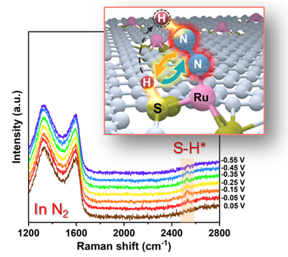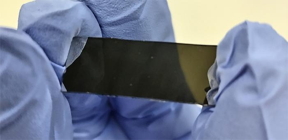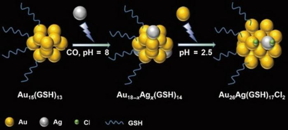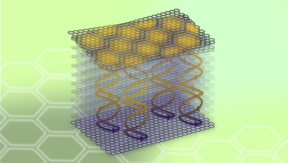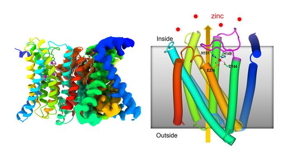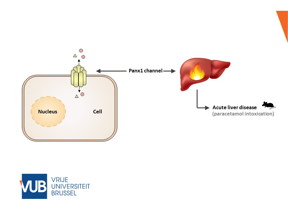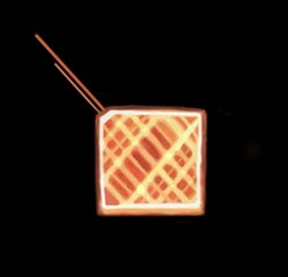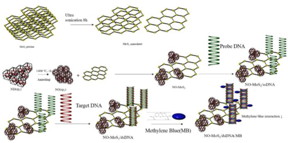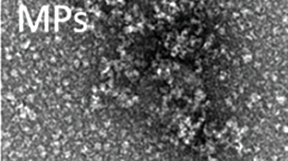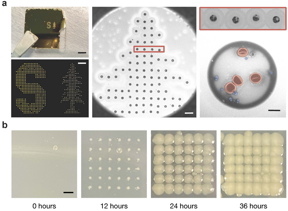Home > Press > Discovery of new Li ion conductor unlocks new direction for sustainable batteries: University of Liverpool researchers have discovered a new solid material that rapidly conducts lithium ions
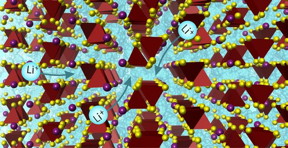 |
| Image represents the lithium ions (in blue) moving through the structure CREDIT University of Liverpool |
Abstract:
One of the grand challenges for materials science is the design and discovery of new materials that address global priorities such as Net Zero.
Discovery of new Li ion conductor unlocks new direction for sustainable batteries: University of Liverpool researchers have discovered a new solid material that rapidly conducts lithium ions
Liverpool, UK | Posted on February 16th, 2024
In a paper published in the journal Science, researchers at the University of Liverpool have discovered a solid material that rapidly conducts lithium ions. Such lithium electrolytes are essential components in the rechargeable batteries that power electric vehicles and many electronic devices.
Consisting of non-toxic earth-abundant elements, the new material has high enough Li ion conductivity to replace the liquid electrolytes in current Li ion battery technology, improving safety and energy capacity.
Using a transformative scientific approach to design the material, the interdisciplinary research team from the University synthesised the material in the laboratory, determined its structure (the arrangement of the atoms in space) and demonstrated it in a battery cell.
The new material is one of a very small number of solid materials that achieve Li ion conductivity high enough to replace liquid electrolytes, and operates in a new way because of its structure.
Its discovery was achieved through a collaborative computational and experimental workflow that used AI and physics-based calculations to support decisions made by chemistry experts at the University.
The new material provides a platform for the optimisation of chemistry to further enhance the properties of the material itself, and to identify other materials based on the new understanding provided by the study.
Professor Matt Rosseinsky, from the University of Liverpool’s Department of Chemistry, said: “This research demonstrates the design and discovery of a material that is both new and functional. The structure of this material changes previous understanding of what a high-performance solid-state electrolyte looks like.
“Specifically, solids with many different environments for the mobile ions can perform very well, not just the small number of solids where there is a very narrow range of ionic environments. This dramatically opens up the chemical space available for further discoveries.
Recent reports and media coverage herald the use of AI tools to find potentially new materials. In these cases, the AI tools are working independently and thus are likely to recreate what they were trained on in various ways, generating materials that may be very similar to known ones.
“This discovery research paper shows that AI and computers marshalled by experts can tackle the complex problem of real-world materials discovery, where we seek meaningful differences in composition and structure whose impact on properties is assessed based on understanding.”
“Our disruptive design approach offers a new route to discovery of these and other high-performance materials that rely on the fast motion of ions in solids.”
The study undertaken was a combined effort between researchers in University of Liverpool’s Department of Chemistry, Materials Innovation Factory, Leverhulme Research Centre for Functional Materials Design, Stephenson Institute for Renewable Energy, Albert Crewe Centre, and School of Engineering.
The work was funded by the Engineering and Physical Sciences Research Council (EPSRC), the Leverhulme Trust, and the Faraday Institution.
The paper `Superionic lithium transport via multiple coordination environments defined by two anion packing’ is published in Science.
####
For more information, please click here
Contacts:
Sarah Stamper
University of Liverpool
Cell: 07970247396
Copyright © University of Liverpool
If you have a comment, please Contact us.
Issuers of news releases, not 7th Wave, Inc. or Nanotechnology Now, are solely responsible for the accuracy of the content.
| Related Links |
| Related News Press |
News and information
![]() Detecting breast cancer through a spit test February 16th, 2024
Detecting breast cancer through a spit test February 16th, 2024
![]() New chip opens door to AI computing at light speed February 16th, 2024
New chip opens door to AI computing at light speed February 16th, 2024
![]() HKUST researchers develop new integration technique for efficient coupling of III-V and silicon February 16th, 2024
HKUST researchers develop new integration technique for efficient coupling of III-V and silicon February 16th, 2024
Chemistry
![]() Researchers develop technique to synthesize water-soluble alloy nanoclusters January 12th, 2024
Researchers develop technique to synthesize water-soluble alloy nanoclusters January 12th, 2024
![]() Focused ion beam technology: A single tool for a wide range of applications January 12th, 2024
Focused ion beam technology: A single tool for a wide range of applications January 12th, 2024
![]() Porous platinum matrix shows promise as a new actuator material November 17th, 2023
Porous platinum matrix shows promise as a new actuator material November 17th, 2023
![]() Ferroelectrically modulate the Fermi level of graphene oxide to enhance SERS response November 3rd, 2023
Ferroelectrically modulate the Fermi level of graphene oxide to enhance SERS response November 3rd, 2023
Govt.-Legislation/Regulation/Funding/Policy
![]() New chip opens door to AI computing at light speed February 16th, 2024
New chip opens door to AI computing at light speed February 16th, 2024
![]() A battery’s hopping ions remember where they’ve been: Seen in atomic detail, the seemingly smooth flow of ions through a battery’s electrolyte is surprisingly complicated February 16th, 2024
A battery’s hopping ions remember where they’ve been: Seen in atomic detail, the seemingly smooth flow of ions through a battery’s electrolyte is surprisingly complicated February 16th, 2024
![]() NRL discovers two-dimensional waveguides February 16th, 2024
NRL discovers two-dimensional waveguides February 16th, 2024
Possible Futures
![]() Detecting breast cancer through a spit test February 16th, 2024
Detecting breast cancer through a spit test February 16th, 2024
![]() A battery’s hopping ions remember where they’ve been: Seen in atomic detail, the seemingly smooth flow of ions through a battery’s electrolyte is surprisingly complicated February 16th, 2024
A battery’s hopping ions remember where they’ve been: Seen in atomic detail, the seemingly smooth flow of ions through a battery’s electrolyte is surprisingly complicated February 16th, 2024
![]() NRL discovers two-dimensional waveguides February 16th, 2024
NRL discovers two-dimensional waveguides February 16th, 2024
Discoveries
![]() HKUST researchers develop new integration technique for efficient coupling of III-V and silicon February 16th, 2024
HKUST researchers develop new integration technique for efficient coupling of III-V and silicon February 16th, 2024
![]() Superbug killer: New synthetic molecule highly effective against drug-resistant bacteria February 16th, 2024
Superbug killer: New synthetic molecule highly effective against drug-resistant bacteria February 16th, 2024
![]() A battery’s hopping ions remember where they’ve been: Seen in atomic detail, the seemingly smooth flow of ions through a battery’s electrolyte is surprisingly complicated February 16th, 2024
A battery’s hopping ions remember where they’ve been: Seen in atomic detail, the seemingly smooth flow of ions through a battery’s electrolyte is surprisingly complicated February 16th, 2024
Announcements
![]() Detecting breast cancer through a spit test February 16th, 2024
Detecting breast cancer through a spit test February 16th, 2024
![]() New chip opens door to AI computing at light speed February 16th, 2024
New chip opens door to AI computing at light speed February 16th, 2024
![]() HKUST researchers develop new integration technique for efficient coupling of III-V and silicon February 16th, 2024
HKUST researchers develop new integration technique for efficient coupling of III-V and silicon February 16th, 2024
Interviews/Book Reviews/Essays/Reports/Podcasts/Journals/White papers/Posters
![]() Detecting breast cancer through a spit test February 16th, 2024
Detecting breast cancer through a spit test February 16th, 2024
![]() New chip opens door to AI computing at light speed February 16th, 2024
New chip opens door to AI computing at light speed February 16th, 2024
![]() HKUST researchers develop new integration technique for efficient coupling of III-V and silicon February 16th, 2024
HKUST researchers develop new integration technique for efficient coupling of III-V and silicon February 16th, 2024
Battery Technology/Capacitors/Generators/Piezoelectrics/Thermoelectrics/Energy storage
![]() A battery’s hopping ions remember where they’ve been: Seen in atomic detail, the seemingly smooth flow of ions through a battery’s electrolyte is surprisingly complicated February 16th, 2024
A battery’s hopping ions remember where they’ve been: Seen in atomic detail, the seemingly smooth flow of ions through a battery’s electrolyte is surprisingly complicated February 16th, 2024
Artificial Intelligence
![]() New chip opens door to AI computing at light speed February 16th, 2024
New chip opens door to AI computing at light speed February 16th, 2024
![]() HKUST researchers develop new integration technique for efficient coupling of III-V and silicon February 16th, 2024
HKUST researchers develop new integration technique for efficient coupling of III-V and silicon February 16th, 2024
![]() 2D material reshapes 3D electronics for AI hardware December 8th, 2023
2D material reshapes 3D electronics for AI hardware December 8th, 2023
![]() Data can now be processed at the speed of light! April 14th, 2023
Data can now be processed at the speed of light! April 14th, 2023
Grants/Sponsored Research/Awards/Scholarships/Gifts/Contests/Honors/Records
![]() ‘Sudden death’ of quantum fluctuations defies current theories of superconductivity: Study challenges the conventional wisdom of superconducting quantum transitions January 12th, 2024
‘Sudden death’ of quantum fluctuations defies current theories of superconductivity: Study challenges the conventional wisdom of superconducting quantum transitions January 12th, 2024
![]() 2D material reshapes 3D electronics for AI hardware December 8th, 2023
2D material reshapes 3D electronics for AI hardware December 8th, 2023
- SEO Powered Content & PR Distribution. Get Amplified Today.
- PlatoData.Network Vertical Generative Ai. Empower Yourself. Access Here.
- PlatoAiStream. Web3 Intelligence. Knowledge Amplified. Access Here.
- PlatoESG. Carbon, CleanTech, Energy, Environment, Solar, Waste Management. Access Here.
- PlatoHealth. Biotech and Clinical Trials Intelligence. Access Here.
- Source: http://www.nanotech-now.com/news.cgi?story_id=57449
- :has
- :is
- :not
- :where
- $UP
- 000
- 10
- 12th
- 14th
- 16th
- 17th
- 26
- 3d
- 3rd
- 4
- 5
- 7th
- 8th
- a
- AC
- accuracy
- Achieve
- achieved
- acute
- address
- against
- AI
- Alloy
- and
- approach
- April
- ARE
- arrangement
- AS
- assessed
- At
- available
- awarded
- away
- based
- batteries
- battery
- BE
- Beam
- because
- been
- between
- Blue
- both
- Breast cancer
- by
- calculations
- CAN
- Cancer
- Capacity
- carbon
- cases
- cell
- Center
- centre
- CGI
- challenges
- Changes
- chemical
- chemistry
- chip
- click
- co2
- collaborative
- COM
- combined
- comment
- commitment
- compatible
- complex
- components
- composition
- computational
- computers
- computing
- conductivity
- conductor
- conducts
- content
- conventional
- Conversion
- coordination
- Cost
- could
- Council
- coverage
- Creating
- credit
- Current
- Death
- December
- decisions
- Decline
- defined
- del
- demonstrated
- demonstrates
- Department
- Design
- designs
- detail
- determined
- develop
- developed
- Devices
- diagnosis
- differences
- different
- direction
- discovered
- Discovers
- discovery
- disruptive
- dna
- Door
- dramatically
- Early
- Effective
- efficient
- effort
- Electric
- electric vehicles
- electrolyte
- electrolytes
- Electronic
- Electronics
- elements
- Emissions
- end
- energy
- Engineering
- enhance
- enough
- environments
- essential
- Ether (ETH)
- experimental
- experts
- factory
- far
- FAST
- February
- Find
- First
- flow
- fluctuations
- For
- Foundation
- from
- functional
- funded
- further
- GAS
- generating
- gif
- Global
- grand
- grand challenges
- Graphene
- greenhouse gas
- Harvesting
- Have
- Health
- help
- High
- high-performance
- highly
- http
- HTTPS
- huge
- human
- identify
- if
- image
- Impact
- improvements
- improving
- in
- Inc.
- independently
- industry
- information
- Innovation
- inorganic
- Institute
- Institution
- integration
- Ionic
- IT
- ITS
- itself
- January
- journal
- just
- killer
- known
- laboratory
- less
- Level
- li
- Life
- light
- like
- likely
- links
- Liquid
- lithium
- locking
- Long
- LOOKS
- Low
- made
- many
- material
- materials
- Matrix
- matt
- May..
- meaningful
- mechanism
- Media
- Media Coverage
- Mobile
- molecule
- monumental
- more
- motion
- moving
- multiple
- nanotechnology
- narrow
- net
- New
- newly
- news
- novel
- November
- now
- number
- of
- Offers
- offset
- on
- ONE
- ones
- opens
- operates
- Optimize
- or
- organic
- Other
- Paper
- pathway
- Paul
- perform
- performance
- PHP
- physical
- Physical Sciences
- physicist
- platform
- platinum
- plato
- Plato Data Intelligence
- PlatoData
- please
- Post
- posted
- potent
- potential
- potentially
- power
- press
- Press Release
- previous
- Problem
- processed
- produce
- promise
- properties
- provided
- provides
- published
- Quantum
- range
- rapid
- rapidly
- reaction
- real world
- release
- Releases
- rely
- remember
- Renewable
- renewable energy
- replace
- Reports
- represents
- research
- researchers
- reshapes
- responsible
- return
- revolutionary
- revolutionize
- Risk
- Route
- s
- safely
- Safety
- Said
- Save
- School
- School of Engineering
- Science
- SCIENCES
- scientific
- scientists
- Screen
- Search
- Seek
- seemingly
- seen
- Semiconductors
- September
- Share
- Shows
- significantly
- similar
- single
- SIX
- small
- smooth
- solely
- solid
- Soon
- Space
- speed
- start
- Step
- structure
- Study
- submit
- such
- sudden
- Superconductivity
- support
- surprisingly
- sustainable
- synthesize
- synthetic
- Systems
- tackle
- Tandem
- team
- technique
- Technology
- than
- that
- The
- their
- There.
- These
- they
- this
- Through
- Thus
- to
- tool
- tools
- towards
- trained
- transformative
- transport
- trial
- Trust
- two
- Uk
- understanding
- university
- unknown
- unlocks
- us
- use
- used
- useful
- various
- Vehicles
- very
- via
- was
- Waste
- Water
- Wave
- Way..
- ways
- we
- WELL
- were
- What
- which
- whose
- wide
- Wide range
- will
- wisdom
- with
- without
- Work
- workflow
- working
- Yahoo
- you
- zephyrnet
- zero











